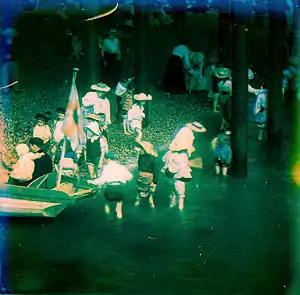Otto Pfenninger | |
|---|---|
 | |
| Born | 5 April 1855 |
| Died | 20 March 1929 (aged 73) Mitcham, Surrey, England |
| Nationality | Swiss |
| Known for | Photography |
-c.jpg.webp)

Otto Pfenninger (5 April 1855 – 20 March 1929)[1] was a founding member of the Swiss Photographers Association (1886) and a pioneer of colour photography. He moved to Brighton, England where he developed his career as a photographer.
In 1906, Pfenninger built a special camera to his own design using 3-colour separated plates from which full-colour photographic images could be created. That summer Pfenninger used this tri-colour, single exposure camera to create some of the first colour photographs, using the parks and beaches of Brighton as scenes.[2] His camera was based upon J.W. Bennetto's one-shot camera of 1897 in which three separation negatives were obtained at a single exposure. Pfenninger tried to use the same system but found that the refracted image was shorter from top to bottom,[3] his solution was to add a glass plate at the same angle, but opposite direction, to the Bennetto reflector.
In 1921,[4] under the pseudonym O. Reg, he wrote Byepaths of Colour Photography in which he discusses in technical detail, the history and theory of developments in subtractive colour photography.
References
- ↑ GRO Croydon Vol. 2a Page 912
- ↑ "Otto Pfenninger - Brighton Photo". www.photohistory-sussex.co.uk. Retrieved 2022-09-15.
- ↑ Brighton and Hove Natural History and Philosophical Society, Abstracts of Papers, Pfenninger lecture 6 December 1907, accessed 17 September 2011
- ↑ E.P. Dutton & Co., New York. The book bears no publication date and other sources state 1924
External links
- Byepaths of Colour Photography, available online